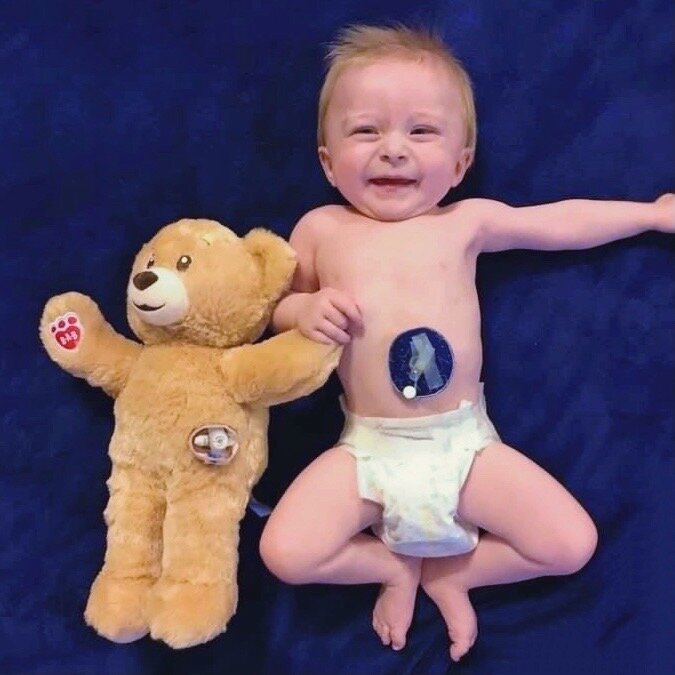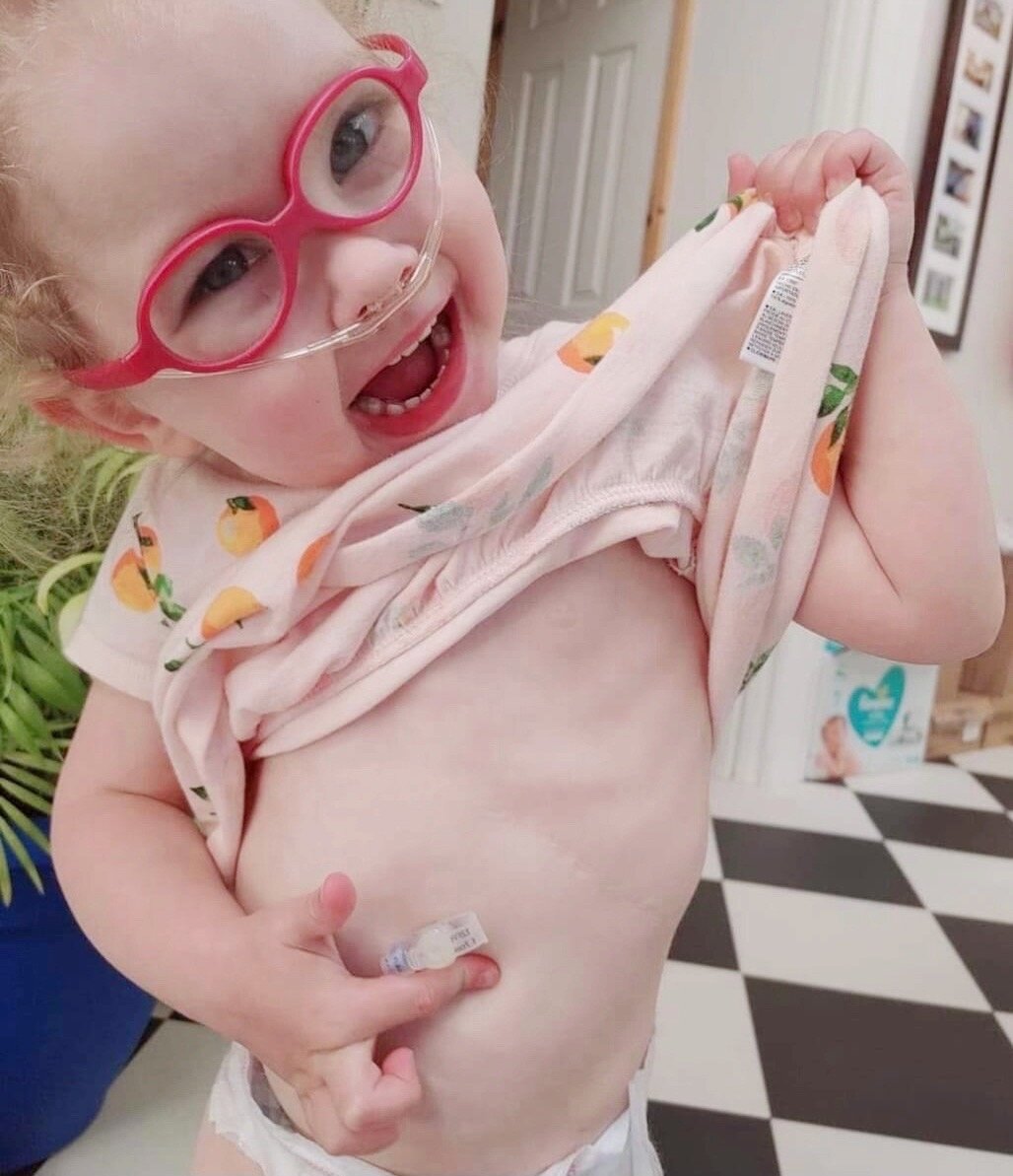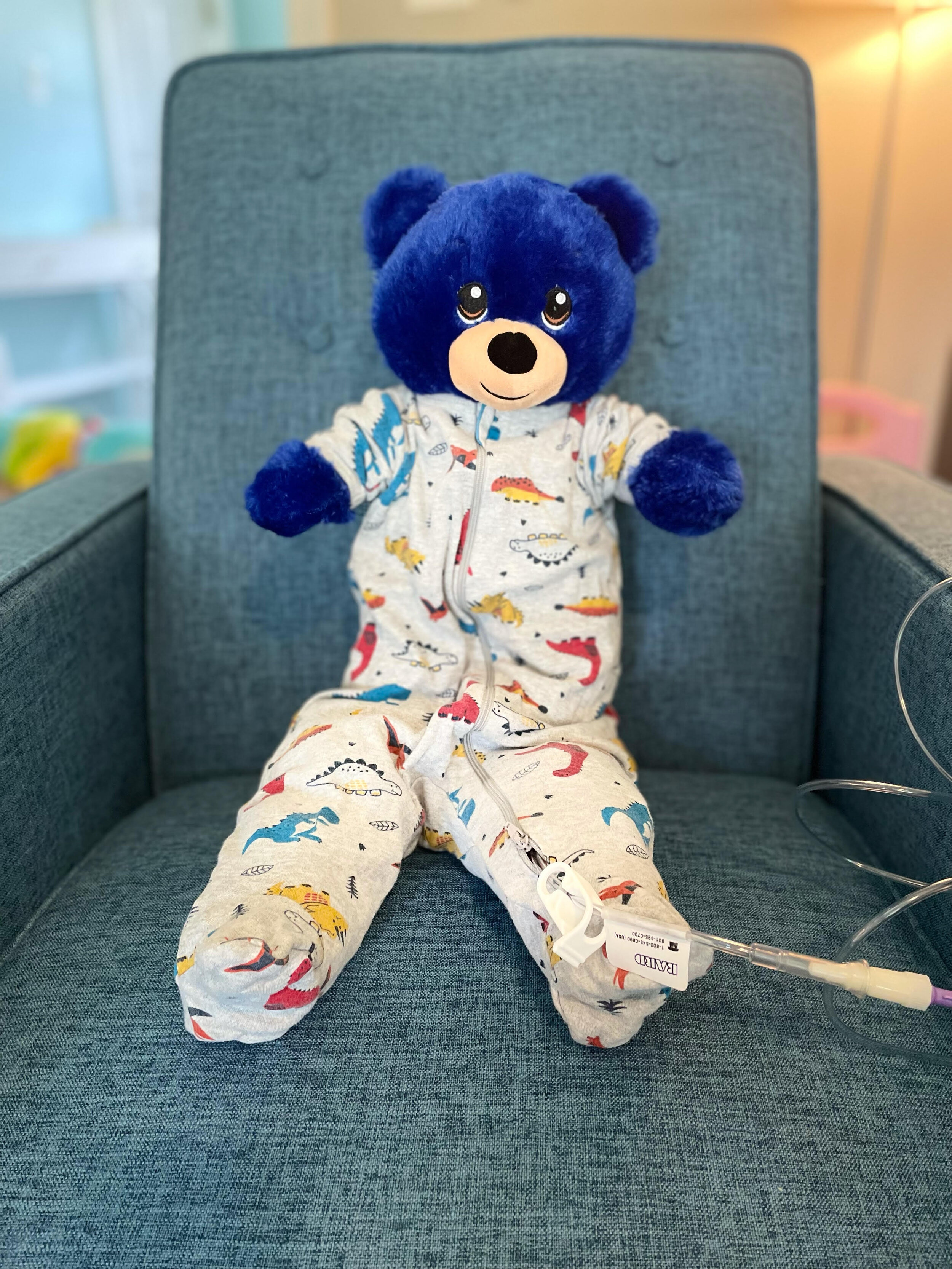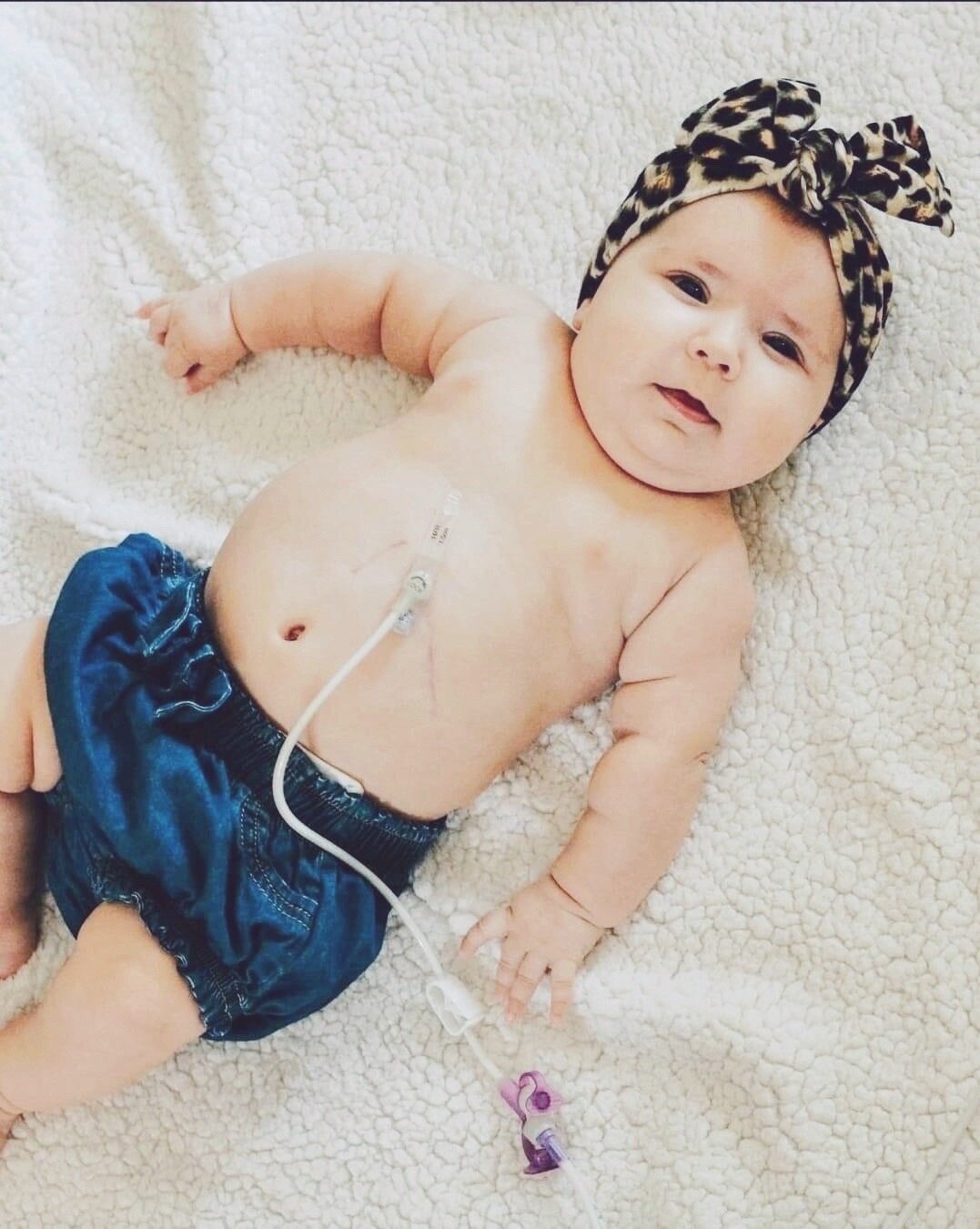G-Tube Equipment 411
After diagnosis, repair, and extubation comes the hurdle of learning to eat. This part of the process will look different for every CDH baby; however, it is very common for our Tiny Heroes to struggle with one or more aspects of the feeding process. Some babies may have difficulty learning to suck and swallow, others may have trouble keeping their food down due to reflux or their anatomy, and many may struggle to take in the volume they need to gain weight. When these bumps in the road occur, it is common for a feeding tube to be recommended until your Tiny Hero can figure things out on their own. In hopes of making this decision seem less scary or foreign, we have compiled many of the most commonly asked G-tube questions for you!
What is the G-tube used for? The G-tube is a tube that is surgically inserted through the abdomen and into the baby’s stomach. This allows you to feed, hydrate, and medicate your baby when they are unable to take enough by mouth. It is simply a tool to help your baby get the calories they need to thrive, so as discouraging as it may feel initially, remember getting a G-tube means you are one step closer to going home and you will have more options for feeding as well. Many CDH babies are able to eat some or most of their feeds orally, even with a G-tube. In these cases you can opt not to use it; however, having the tube as backup will allow you to easily supplement or push fluids on days when they are too tired or sick to finish their feeds. It also allows you to administer feeds overnight, which encourages better sleep since your baby won’t be waking up hungry overnight.
What does a G-tube look like? Here is an image of a G-tube from the outside.
What are the parts of a G-Tube? There are three main parts. First, your baby will have the G-tube itself (this is the part that is on the outside of their abdomen). Some G-tubes have a balloon at the end of the tube that is inflated and others have a mushroom-style (this is the part that is inside their abdomen). Your surgeon will use whichever style they feel is best but don’t feel like you can’t ask questions about the various styles and decide together which is best for your family. They will give you several types of extension pieces. Some will have a feeding port and a medication port on it, some will just be used for feeding, while some can be used for multiple uses. From this port, you will use a syringe to administer the feeding and medication or use the extension to connect a that holds the food.
How do you hook up a feed? Not to worry, your baby’s nurses will make sure you are experienced with this process before you come home. However, in general, to hook up a feed, you will mix up your formula according to the directions (or use breastmilk) and fill the bag. You will then hook the bag to the feeding pump and prime the line. To prime the line, you can press and hold the “prime button” on your feeding pump and wait until the milk fills the entire line, or if you have an infinity pump, you can prime the line by hand more quickly by pressing the valve on the cassette that goes in the pump (near the teardrop symbol) and gently squeezing the bag. If you plan to place the feed in a backpack rather than hanging it up, you may want to hold the bag upside down during this process (for the infinity) to help remove all of the excess air from the bag. This will keep your pump from alarming that the bag is empty when it isn’t and shutting off due to air in the line. Once the line is primed, you will set the pump to the feed amount and length of time the feed will be (i.e. 30mL per hour over 5 hrs). Remember, when using a feed bag, be sure to add an additional 10-20 mLs to make up for what will be left in the line when the feed is finished. Then plug the extension into the port and start the pump. Once the feed is complete, the pump will shut off. Some pumps will sound an alarm when it ends, but you are able to turn this setting off if you choose.
Can I give medication through G-tube? Yes, this is definitely a perk to having a G-tube (another being that you can easily push fluids when they are sick)! When it comes to administering medication with some G-tubes, you can also use slip tip syringes instead of the extension. The most important thing is to remember to flush the tube with a small amount of water or milk after to ensure the medication does not stay in the tube or extension.
What to do if the G-tube is pulled out? If the G-tube is pulled out, and it is a balloon-type (like Mic-key or MiniOne), and the balloon is not harmed, you will deflate it with the appropriate syringe, place it back in the stoma (the hole in the abdomen), and then re-inflate the balloon. If the balloon is damaged upon being ripped out, you will need to obtain a backup button and insert it using the steps above. For this reason, it is always good to have a backup on hand. However, if you do not have a backup, you can go to your local children’s hospital or the GI office for a replacement. If your child’s G-tube is a mushroom type, you will have to go to the children’s hospital or doctor to put another one in place for you. These cannot be replaced at home by the parents.
Will they need it forever? For many Tiny Heroes, the G-tube will only be used for the first year or two of life while they learn to eat by mouth. Many families have found success with weaning from the G-tube using things such as feeding therapy, chiropractics, releasing tongue and lip ties, and using the Facebook group “Growing Independent Eaters.” Our blogs on Oral Aversions, Making Eating Fun, and Healthy Weight Gain Tips also contain many tips and tricks to wean from the G-tube.
What is the difference between continuous feeds and scheduled feeds? Continuous feeds run continuously for a set amount of time (i.e., overnight for 8-12 hours), whereas a scheduled feed will occur at certain times of the day (similar to when you would do bottle feedings).
How can feeds be administered? There are three ways you can feed your CDH baby with their G-tube. There are pump feeds, bolus feeds, and gravity feeds. A pump feed is delivered using the pump (provided by the DME) which allows you to set the exact amount of food you would like to administer as well as the duration of time it will take. This is nice because you can give a continuous feed over the span of many hours, including overnight, while you sleep. The bolus and gravity feeds, on the other hand, are done manually. For a bolus feed, you will fill a large syringe with the feed amount and push the contents directly into the G-tube yourself all at once and, for a gravity feed, you will place the feed into an open syringe and let gravity slowly administer the feed. Remember to prime the line for pump and bolus feedings.
Do I have to use formula? The decision of what to feed your Tiny Hero will be made by your baby’s team, but, in most cases, you will not be limited to formula if you desire to use breastmilk. Breastmilk is a great source of nutrition and simply having a G-tube usually will not interfere with your ability to pump milk for your baby. However, depending on their dietary needs, you may need to eliminate certain reflux-inducing foods from your diet or fortify the breastmilk with formula. Fortifying will increase your baby’s caloric intake without needing to increase the volume of milk ingested. If your child remains on a G-tube past infancy, you will be able to choose between a complete nutritional formula intended for older kids or a blended diet. A blended diet allows you to blend real food into a puree to feed your child or use already pureed baby food. Your child’s nutritionist will guide you on what will work best for your child’s needs.
What is venting? Venting is how you decompress the air from your child’s belly using a special extension called a decompression tube. Some people will do this before, during, and/or after feeds. If your child had a Nissen fundoplication, this will likely be necessary more often than if they did not. Some tubies may reach the point where they no longer need to be vented much or at all. If your child retches frequently, ask your doctor about medications that could help with this. If you are doing continuous feeds, you may want to ask about the Farrell Valve Bag which allows the air to be vented out during a continuous feed.
Can my baby take baths with a G-tube? Yes, being in bath water and pools with a G-tube is perfectly fine. You can talk with your medical team to verify what is best for your child, but many doctors are also okay with them swimming in lakes and oceans as well.
Can they wear regular clothes? Yes, you will find some outfit styles easier to access the G-tube than others, but there is no need to purchase expensive adaptive clothing unless you prefer to do so. T-shirts, dresses, and certain button-down outfits work great. It might take a little trial and error to figure out what works, but you will probably opt to skip onesies and zip-up sleepers. For overnight continuous feeds, you may want to consider inverted or 2-way zipper sleepers. This allows you to have the tubing come out of the pajamas by your child’s foot, holding it securely by the leg and as far away from the neck as possible (Cloud Island at Target and Carter’s both have great options for this). Snap up sleepers or open bottomed gowns also provide quick and easy access to the tube while also keeping any tubing away from their necks.
What is a DME supplier? What do they do for me? G-tubes are considered Durable Medical Equipment (DME) and your insurance will work with you to get coverage for your DME supplies. Keep in mind that it is always better to have extras of things (formula included) than not enough - so take what they will give each month, even if you generally do not use that quantity. In the event of a natural disaster, a shipping delay, or other unforeseen events, you will be happy to have a stockpile of necessary supplies. Also, remember that you are generally not stuck with one specific supplier when it comes to DME suppliers. If they are constantly dropping the ball and leaving you without the needed supplies, it is okay to find a different company. The right company will make it a seamless process with automatic monthly deliveries to your house so you do not have to go out and buy most anything yourself. Some insurance companies will cover formula while others will not. However, do not be afraid to call your insurance and appeal any denials. Many times, insurance will try to deny formula coverage the first time around, but with the right information from the GI doctor, your surgeon and/or you, many parents are able to get it covered in the end.
What happens when they don’t need it anymore? After a while of going unused, you and your child’s doctor will work together to come up with a plan for having it taken out. This is done in the office most times, and the hole will typically heal on its own. But if it does not, your child may need it surgically closed after a few months. This simple procedure is so easy compared to everything else your child has been through, so hopefully this will be a seamless transition for you and your family.
When do I call the doctor? If you are ever concerned your child has an infection of their stoma, their stomach content contains blood or bile, the G-tube has come out, or anything looks or seems off, call the pediatrician, GI or surgeon immediately. It is always better to make the call early than to regret not making a call you should have made. The doctor will be able to advise you of the next steps or ease your mind. That is what they are there for, so never hesitate to call. Trust your mom/dad instincts!
How do I keep my rolling baby from getting tangled in the line at night? This can definitely happen, but many people have found success with swaddling at night or putting the line through the leg of the pajama and out the bottom (you can use snap up sleepers, cut a hole in traditional zipper sleepers or look for inverted or 2-way zippers). Having an Owlet monitor and video baby monitor can also provide peace of mind overnight.
How do I keep my mobile toddler still enough to do a full feed? The short answer is that you probably won’t. Small backpacks can be great for allowing them to move around while the pump is feeding them. You may also opt to have them sit in a cozy coupe car or walker during their feeds so they can move around. Some parents find going for a walk in the stroller is the best way to keep them still and entertained.
What products will make life easier? After surveying dozens of CDH families these are the products that come highly recommended! You can view a full list of our favorites here.
Brushes to clean the lines
The Flying Squirrel – a feeding pump holder to hold the infinity pump so that it doesn’t need to be hooked to the pole or in a backpack.
Tubie Guard or AMT Clamps – This allows you to put the port end of the extension into it and makes it so the med port can’t open, which eliminates “feeding the bed” at night.
Tubie Pads – These cute pads can be used in place of gauze to absorb any leakage.
Large Zip Lock Bags – The Infinity pump is pretty much water proof, but it can’t be submerged. When swimming you can place the pump into a ziplock back for extra protection. These are also great for keeping the extensions and various accessories together in one place and clean.
Desitin or calmoseptine – These work great for red and irritated tube sites (not to be used for infected sites)
Baby Saline Spray – Saline spray is a great way to clean the site quickly
Packit Lunch Box – This lunch box has a built-in ice pack that helps keep feed bags cool so you do not have to switch it out overnight.
Slip Tip Syringes – These will administer medicine right into the miniOne button and the Mic-Key button. It makes it so you do not need to get the extension attached.
Baby Aquaphor or Vaseline – Place it around the stoma before adding gauze to help prevent irritation from stomach acid or things rubbing against the skin
Small Hair Tie – These can be used to keep the G-tube closed for the styles that don’t have a lock
Granulotion - This ointment help removes granulated tissue around the stoma
Snap up or footless sleepers, inverted or 2-way zipper sleepers - as your child gets more mobile while sleeping, this allows you to have the tubing go down along their leg and out by the foot to reduce the risk of strangulation (gowns can also help with this, though it is recommended to attach the tubing to the end of the gown using tape or something similar)
Be sure to check out these G-Tube related blogs on Accepting the G-Tube and Fed is Best!
***Please note that we are not medical professionals. These are tips and tricks combined from a group of G-tube experienced CDH families eager to help you navigate life with a tubie! Be sure to always run any medical advice you receive by their pediatrician, GI or pediatric surgeon.








